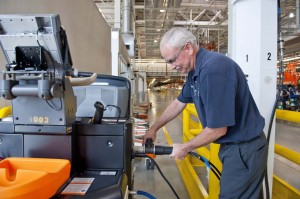Remember the fuel cell? Not all that long ago, it seemed like the technology bound to replace the internal combustion engine.
But, for the moment, at least, the hydrogen-based power source has fallen out of favor, the automotive world now focusing its attention on more promising battery technology.
But while the hopes of switching to hydrogen power in the next decade may be largely gone, the fuel cell is anything but forgotten, as BMW is demonstrating at its newly-expanded assembly plant in Spartanburg, South Carolina.
The German maker will be switching from conventional forklifts, tuggers and stackers to ones powered by compact fuel cell systems, it says.
There’s a heavy emphasis on sustainability at the enlarged factory, which is now ramping up production of the next-generation X3 crossover, explains Josef Kerscher, President of BMW Manufacturing. “There’s a clear vision and determination to reach our goal of using renewable energy as much as possible throughout the plant site.”
Fuel cells are actually a relatively simple technology. Hydrogen gas is forced into one side of what is known as a fuel cell stack. Oxygen, from the air we breathe, is used on the other side. The lighter gas squeezes through a fine mesh coated with a catalytic material, such as platinum, leaving behind an electron. As enough hydrogen is fed into the stack it produces a steady stream of current. The only by-product is pure water, or H2O.
Initially, BMW plans to operate 85 fuel-cell powered machines, which would make it one of the largest hydrogen-powered fleets in the country. The stacks, provided by Plug Power, Inc., can operate up to 10 hours on 2 kilograms of hydrogen – the energy equivalent of about 2 gallons of gasoline. Refueling takes about three minutes using a new hydrogen filling station on the plant site.
BMW was a strong and early proponent of using hydrogen in passenger cars, but it took an alternative approach from most of the rest of the industry.
The German maker is still field-testing a fleet of Hydrogen7 sedans, modified 7-Series models that feed hydrogen into their internal combustion engine, replacing the use of gasoline. The current prototype is actually a bi-fuel vehicle, able to switch from hydrogen to gasoline at the touch of a button.
While there are still a number of proponents who believe that hydrogen will eventually regain its footing as the cleanest automotive power source, skeptics contend that the gas is costly, difficult to produce and store and will find, at best, limited applications.
The U.S. government appears to agree. The Department of Energy has steered significant research and development funds, originally earmarked for hydrogen programs, towards the development of advanced batteries and battery-electric vehicles.

